Marie Brennan's Blog, page 238
February 7, 2011
Revisiting the Wheel of Time: A Crown of Swords
[This is part of a series analyzing Robert Jordan's Wheel of Time novels. Previous installments can be found under the tag. Comments on old posts are welcome, but please, no spoilers for books after Crossroads of Twilight, as that's the last book I read before starting this project.]
Back in the day, I think A Crown of Swords was my favorite book in the series. As I've said before, it's the one I waited the right length of time for (enough to build anticipation, not enough to become annoyed); furthermore, it has a lot of Mat, and also some really good moments for both Elayne and Nynaeve. In retrospect, it isn't as good as The Shadow Rising -- which will probably remain the best-constructed slice of this sprawling narrative, unless Sanderson really knocks my socks off -- but it's okay. Its major weakness is probably the fizzle of confrontation at the end. (A lot of people apparently complain about how little time passes during the book, but a) man, that must take obsessive work to figure out, since there are no dates given and b) I don't care about time so much as plot elapsed. And while this one is firmly in the throes of "too many new plots, not enough resolution," stuff does happen.)
I'll get to the plot construction in a minute, but first: exciting news! I think I've figured out Faile. But I need other people to check my characterization math, because I don't have a copy of Lord of Chaos around to see if I'm correctly remembering her behavior there, and I don't remember what happens later well enough (especially the bits from Faile's pov).
So, my epiphany started with a rare moment of sympathy for Faile. For once, I understood where she was coming from, after the showdown with Colavaere; she put herself at risk to get evidence against the woman, only to see her evidence ignored and Berelain's (by way of her thief-catchers) taken as damning. Yeah, I'd be pissed too. Of course, right after that moment, there was a much less rare moment of wtfery, as Perrin yelling at Faile makes her melt. Pondering it this time around, I thought that maybe this was Jordan trying to do the old-skool romance thing -- that what Faile wants is an "alpha male." But an alpha male, in the romance-genre sense, would probably try to keep her safe, and that clearly isn't what Faile's after. In fact, she gets annoyed and/or hurt when Perrin's idea of protecting her means keeping her away from danger.
. . . and, if memory serves, she likewise feels hurt when he tries to speak uber-gently to her. Furthermore, she again feels hurt, and jealous, when he yells at Berelain to stay away from him.
I think, to Faile's way of thinking, gentleness and protection = disrespect. The message she takes from it is that Perrin thinks she's fragile.
Whereas when he yells at Berelain, it shows a kind of respect for the other woman. I don't think Faile believes Perrin is in love with Berelain, but -- let me make an analogy. Pretend they are all ordinary people in the real world. Perrin does not like his job, and so when Faile asks him about it, he brushes her off, thinking he's sparing her boredom and/or annoyance. Berelain, however, is a colleague of his, and so he regularly talks about work to her, sometimes when Faile is around. To Faile's eye, this looks like her husband has no respect for her intelligence: "oh, don't worry your pretty little head about it." But he does respect Berelain. Replace "intelligence" with "toughness" and "talking about work" with "being forceful in his opinions," and I think that's what's going on here.
The thing is, I could actually get behind this dynamic . . . if Jordan were able to execute it in a way that didn't come across as borderline abusive. The whole "leopard" metaphor between Faile's parents does not cast it in a good light, especially when physical confrontation is apparently not only an acceptable but a desirable way to make one's point. But I can see Faile being frustrated by her husband treating her as if she's made of spun glass, when she prides herself on her strength. It's a common enough trope when it comes to physical danger -- Min yells at Rand, later on, for his "I have to keep you safe" bullshit -- and it isn't unreasonable to extend it to conversational arenas as well. There are people out there with perfectly functional relationships whose bedrock is top-of-the-lungs disagreements (often followed by great sex). The problem here is that Perrin doesn't realize that's Faile's game.
(And she won't tell him. But refusal to tell anybody anything is possibly the single most endemic illness among characters in this series, only occasionally going into remission, so she's hardly alone in that.)
Aside from that epiphany, there are other moments with female characters that I quite enjoy in this book. Birgitte, for one; this marks the start of her friendship with Mat, and it's such a freaking breath of fresh air -- largely because Jordan doesn't use the usual female cookie-cutter on her. She likes drinking; she likes pointing out women for Mat (and having men pointed out for her), and she actually says what she means. THANK GOD. More like her, please? Also two fleeting touches with other characters, that please me entirely out of proportion to their size: the first is Sulin's reaction when they tie Rand's hands for sneaking into Caemlyn (she realizes Galina's crew tied Rand up, and almost cuts him free on the spot), and then Samitsu's response to Flinn's Healing of Rand ("I will pay you, have your babies, anything, just TELL ME WHAT YOU DID"). I want more characters like Samitsu, too: women who have something they're really passionate about, to the extent that they will chuck scheming and secrecy and everything else out the window to get at their target.
Unfortunately, this book also has Tylin. And, erm. Problems.
The really frustrating thing is, I think I see what Jordan was trying to do, and if he hadn't completely overshot his target and fallen into the abyss of Wrong Wrong Just NO, it would have been great. Mat says it himself: he chases women, not the other way around. Making him the object of desire -- a feminized position -- with Tylin calling the shots could have been hilarious. In fact, it's pretty evident by the reactions of the other characters that Jordan thought it was hilarious. But even in high school, when I first read this book, I know Tylin's single-minded pursuit bothered me; revisiting it now, I realize that her actions wander close to -- possibly over -- the border of rape.
The only reason I don't call it rape outright is that we don't get much detail -- Jordan fades to black very quickly -- so Mat's exact mindset during the festivities is unknown. But let's summarize the context: Tylin fancies Mat. He thinks she's pretty, but is a) worried about consequences to snogging the Queen of Altara and b) put off by her approach. He communicates his lack of cooperation by measures including but not limited to hiding from her and locking the door of his room. Tylin responds by trying to starve him out, then breaks into his locked room, holds him at knifepoint, cuts off his clothes, and has her way with him. Mat's response to this afterwards is not "whee, that was fun, let's do it some more," but rather to go on hiding from Tylin. She, in turn, uses his scarf to tie him up (without asking), has her servants move his stuff into her rooms (again without asking), and makes plans to dress him according to her own desires (does she ask? Of course not). In general, she treats all of his refusals as part of the game, and uses her social power to coerce him into playing.
This is not okay.
Mat's line later on about how he'll miss her after all does not take the skeeve off the situation. Gender-flip the relevant scenes, and it becomes obviously horrifying; furthermore, it becomes the kind of thing we are repeatedly assured Mat himself does not do (nor have we been given reason to doubt him). The women he flirts with flirt back, in unambiguous fashion. I don't mind Mat holding back from flirting with Tylin because she's the Queen of Altara; that's an objection that could be dropped once it became obvious that she's game if he is. I don't mind him being initially uncomfortable with his role as the hunted one, rather than the hunter, if that faded away under the realization that the roles don't matter so long as they both enjoy the outcome. But his objections don't go away. He resists becoming Tylin's boy-toy, and goes on resisting, and Tylin doesn't care whether she has his consent or not. I think Jordan would have seen the problem in a heartbeat if a male character had treated a female one that way -- but in his attempt to flip Mat's usual pattern on its head, he goes too far, and doesn't seem to notice.
Grargh. Okay. Let's move on and talk about story structure.
The thing I really noticed, reading this book, is how Jordan tends to work in narrative blocks. After the usual prologue montage, we get a hundred pages of Perrin and Rand, a hundred pages of Egwene and the Salidar crew, sixty pages of Ebou Dar, etc. Aside from three chapters in the middle -- "Mindtrap," with Moghedien, "The Irrevocable Words," with Morgase, and "To Be Alone," where we cut briefly back to Perrin -- once the focus shifts to a particular corner of the plot, it generally stays there for a while. Given that the various sub-plots don't intersect with each other that often, but rather go off on long, looping arcs that don't touch Rand directly for books at a time, I think this actually makes sense. Intercutting is most effective when the thing you see in one strand somehow connects to or comments on the next, and that doesn't happen too often here. (In fact, sometimes it could and doesn't: we leave Rand on a "please Mat get Elayne here soon" moment, and cut to . . . Egwene.)
But the consequence of this, of course, is that it plays merry hell with the usual structure of a novel. Rand's central position dictates that whatever he does will generally be the focus of the final chapters; therefore, climactic moments in other plotlines have to happen elsewhere in the book. The action rises and falls and rises and falls and rises and -- you get the idea. No smooth curve of growing tension here. The necessity of timeline management complicates this further; I have no idea how much Jordan restricted himself from stepping back in chronology when he switches strands, but he uses a trick here, several times, of a half-page italicized flashback to cover something that happened before whatever chapter we're actually reading. It's not terribly effective, I'm afraid, especially since sometimes what he's skipping mostly over would have been a scene worth reading. He does this a lot with Perrin, for whatever reason, and I really wish he'd written out the staged confrontation with Rand. I understand why he didn't; it would have been impossible to make us believe the confrontation was real, the way he tries to do with the actual chapter ("To Be Alone," which gives us the aftermath). But since the confrontation is more exciting than its aftermath, I don't think the deception is worth the effort. Much better to have us be afraid that Perrin's pissed Rand off a little too convincingly.
He's also still way too fond of cutting away for brief, unnecessary villain pov. We get a scene for Carridin, Mili Skane, and Sammael; another one for Joline and Teslyn; a third for Falion and Ispan. Aside from reminding us of who some of those characters are (seriously, I'd half forgotten the Black Ajah pair), these scenes do . . . what? Tell us there are people scheming to take out Elayne and Nynaeve? What a shocker. Honestly, these feel to me like the kind of scenes Jordan might write for his own benefit, to keep track of where his villains are and what they're doing -- but that doesn't mean they're worth the reader's time.
Oddly, there's another flaw in this book, that I don't remember seeing in previous ones: Jordan has begun shoehorning in expository paragraphs in the oddest (and least successful) places. Seriously, early in Egwene's bit, there's a four-paragraph stretch that goes, "blah blah" <exposition> <exposition> "blah blah," she went on without pause. As in, that second bit of dialogue follows immediately on the first. Contrary to what the two intervening paragraphs (which take up most of the page) would have you believe. And the second bit of dialogue involves something shocking, but apparently we have to stop for two more paragraphs, these describing what Siuan and Leane are wearing, before we actually get their reactions. It's possible Jordan did this occasionally before, but it's all over the place in this book, and really creates a sense that his basic craft is slipping while he juggles all the balls he's put into the air.
Having said that: stuff actually does happen, to a much greater extent than I feared. It gets off to a slowish start, with the usual scattershot prologue and then a moderately tedious (and not quite shell-shocked enough) aftermath to Dumai's Wells -- but Niall gets gacked in that prologue, and then there's Colavaere's attempted coup, and Egwene learning about Moghedien's escape from the previous book, and the blackmail from Nicola and Areina, and the confrontation with Myrelle, and so on. All of the major plot strands involve the characters accomplishing something meaningful (bar the fact that Perrin is largely pov to Rand's actions, rather than acting in his own right). If those random expository paragraphs were shuffled off to better locations, and the villains didn't all suck (seriously, Elaida, palace, wtf), it would be structurally pretty sound. Weak ending confrontation, but really, how many Power battles with Forsaken can you have before it gets to be old hat? I'm looking forward to Winter's Heart, where (if I recall correctly) Rand spends the entire final showdown busy with his pet project while everybody else has a running slap-fight through the forest.
One worldbuilding thing: I feel increasingly as if Jordan plays favorites with the Ajahs. Clearly he's fond of the Blues, what with Moiraine and Siuan, and there are enough cool Greens in the story -- especially with Elayne and Egwene choosing that Ajah -- that I think it's safe to say Jordan finds them interesting, too. And the Reds, of course, are largely there to be antagonists (though I do so appreciate the introduction of Pevara, a non-bitchy, non-evil, non-man-hating Red). In the case of Brown and Yellow, I think his investment ends at a few characters, basically Verin and Nynaeve; beyond those two, the Ajahs are mainly plot devices for exposition and Healing. And I don't think he has much use for the Grays and the Whites at all. Seriously, I'm not even sure why those Ajahs exist; why not fold the Grays into the Blues, given that both do political work? Or, if you want them to be more impartial than the Blues, why not merge the Grays and the Whites? I can see a role for mediators, but I fail to understand why there's an entire Ajah of philosophers. How do they justify their existence? Why isn't that work done by Browns instead? Seriously, if I were running a WoT game, I would probably house-rule two Ajahs together, and come up with a new one to fill the gap. Not sure what they would do, but I could think of something.
Sadly, I've had to give up reading Leigh Butler's recaps over on Tor.com; I'm starting to hit way too many spoilers for Knife of Dreams (and in another book or two of recapping, there would be Gathering Storm spoilers, too). Unfortunately, I'm also beginning to think I need to avoid the Wheel of Time wiki, too; an injudicious click while looking something up outed a particular character as a member of the Black Ajah. <sigh> Pity; Leigh's posts were good for making me think of other stuff I wanted to say. And the wiki is good for refreshing my memory on things. But I'm trying to avoid spoilers, so.
Next up, The Path of Daggers, in which my favorite character takes his sabbatical from the narrative. <sigh again> Well, say it with me: at least it isn't Crossroads of Twilight.
Back in the day, I think A Crown of Swords was my favorite book in the series. As I've said before, it's the one I waited the right length of time for (enough to build anticipation, not enough to become annoyed); furthermore, it has a lot of Mat, and also some really good moments for both Elayne and Nynaeve. In retrospect, it isn't as good as The Shadow Rising -- which will probably remain the best-constructed slice of this sprawling narrative, unless Sanderson really knocks my socks off -- but it's okay. Its major weakness is probably the fizzle of confrontation at the end. (A lot of people apparently complain about how little time passes during the book, but a) man, that must take obsessive work to figure out, since there are no dates given and b) I don't care about time so much as plot elapsed. And while this one is firmly in the throes of "too many new plots, not enough resolution," stuff does happen.)
I'll get to the plot construction in a minute, but first: exciting news! I think I've figured out Faile. But I need other people to check my characterization math, because I don't have a copy of Lord of Chaos around to see if I'm correctly remembering her behavior there, and I don't remember what happens later well enough (especially the bits from Faile's pov).
So, my epiphany started with a rare moment of sympathy for Faile. For once, I understood where she was coming from, after the showdown with Colavaere; she put herself at risk to get evidence against the woman, only to see her evidence ignored and Berelain's (by way of her thief-catchers) taken as damning. Yeah, I'd be pissed too. Of course, right after that moment, there was a much less rare moment of wtfery, as Perrin yelling at Faile makes her melt. Pondering it this time around, I thought that maybe this was Jordan trying to do the old-skool romance thing -- that what Faile wants is an "alpha male." But an alpha male, in the romance-genre sense, would probably try to keep her safe, and that clearly isn't what Faile's after. In fact, she gets annoyed and/or hurt when Perrin's idea of protecting her means keeping her away from danger.
. . . and, if memory serves, she likewise feels hurt when he tries to speak uber-gently to her. Furthermore, she again feels hurt, and jealous, when he yells at Berelain to stay away from him.
I think, to Faile's way of thinking, gentleness and protection = disrespect. The message she takes from it is that Perrin thinks she's fragile.
Whereas when he yells at Berelain, it shows a kind of respect for the other woman. I don't think Faile believes Perrin is in love with Berelain, but -- let me make an analogy. Pretend they are all ordinary people in the real world. Perrin does not like his job, and so when Faile asks him about it, he brushes her off, thinking he's sparing her boredom and/or annoyance. Berelain, however, is a colleague of his, and so he regularly talks about work to her, sometimes when Faile is around. To Faile's eye, this looks like her husband has no respect for her intelligence: "oh, don't worry your pretty little head about it." But he does respect Berelain. Replace "intelligence" with "toughness" and "talking about work" with "being forceful in his opinions," and I think that's what's going on here.
The thing is, I could actually get behind this dynamic . . . if Jordan were able to execute it in a way that didn't come across as borderline abusive. The whole "leopard" metaphor between Faile's parents does not cast it in a good light, especially when physical confrontation is apparently not only an acceptable but a desirable way to make one's point. But I can see Faile being frustrated by her husband treating her as if she's made of spun glass, when she prides herself on her strength. It's a common enough trope when it comes to physical danger -- Min yells at Rand, later on, for his "I have to keep you safe" bullshit -- and it isn't unreasonable to extend it to conversational arenas as well. There are people out there with perfectly functional relationships whose bedrock is top-of-the-lungs disagreements (often followed by great sex). The problem here is that Perrin doesn't realize that's Faile's game.
(And she won't tell him. But refusal to tell anybody anything is possibly the single most endemic illness among characters in this series, only occasionally going into remission, so she's hardly alone in that.)
Aside from that epiphany, there are other moments with female characters that I quite enjoy in this book. Birgitte, for one; this marks the start of her friendship with Mat, and it's such a freaking breath of fresh air -- largely because Jordan doesn't use the usual female cookie-cutter on her. She likes drinking; she likes pointing out women for Mat (and having men pointed out for her), and she actually says what she means. THANK GOD. More like her, please? Also two fleeting touches with other characters, that please me entirely out of proportion to their size: the first is Sulin's reaction when they tie Rand's hands for sneaking into Caemlyn (she realizes Galina's crew tied Rand up, and almost cuts him free on the spot), and then Samitsu's response to Flinn's Healing of Rand ("I will pay you, have your babies, anything, just TELL ME WHAT YOU DID"). I want more characters like Samitsu, too: women who have something they're really passionate about, to the extent that they will chuck scheming and secrecy and everything else out the window to get at their target.
Unfortunately, this book also has Tylin. And, erm. Problems.
The really frustrating thing is, I think I see what Jordan was trying to do, and if he hadn't completely overshot his target and fallen into the abyss of Wrong Wrong Just NO, it would have been great. Mat says it himself: he chases women, not the other way around. Making him the object of desire -- a feminized position -- with Tylin calling the shots could have been hilarious. In fact, it's pretty evident by the reactions of the other characters that Jordan thought it was hilarious. But even in high school, when I first read this book, I know Tylin's single-minded pursuit bothered me; revisiting it now, I realize that her actions wander close to -- possibly over -- the border of rape.
The only reason I don't call it rape outright is that we don't get much detail -- Jordan fades to black very quickly -- so Mat's exact mindset during the festivities is unknown. But let's summarize the context: Tylin fancies Mat. He thinks she's pretty, but is a) worried about consequences to snogging the Queen of Altara and b) put off by her approach. He communicates his lack of cooperation by measures including but not limited to hiding from her and locking the door of his room. Tylin responds by trying to starve him out, then breaks into his locked room, holds him at knifepoint, cuts off his clothes, and has her way with him. Mat's response to this afterwards is not "whee, that was fun, let's do it some more," but rather to go on hiding from Tylin. She, in turn, uses his scarf to tie him up (without asking), has her servants move his stuff into her rooms (again without asking), and makes plans to dress him according to her own desires (does she ask? Of course not). In general, she treats all of his refusals as part of the game, and uses her social power to coerce him into playing.
This is not okay.
Mat's line later on about how he'll miss her after all does not take the skeeve off the situation. Gender-flip the relevant scenes, and it becomes obviously horrifying; furthermore, it becomes the kind of thing we are repeatedly assured Mat himself does not do (nor have we been given reason to doubt him). The women he flirts with flirt back, in unambiguous fashion. I don't mind Mat holding back from flirting with Tylin because she's the Queen of Altara; that's an objection that could be dropped once it became obvious that she's game if he is. I don't mind him being initially uncomfortable with his role as the hunted one, rather than the hunter, if that faded away under the realization that the roles don't matter so long as they both enjoy the outcome. But his objections don't go away. He resists becoming Tylin's boy-toy, and goes on resisting, and Tylin doesn't care whether she has his consent or not. I think Jordan would have seen the problem in a heartbeat if a male character had treated a female one that way -- but in his attempt to flip Mat's usual pattern on its head, he goes too far, and doesn't seem to notice.
Grargh. Okay. Let's move on and talk about story structure.
The thing I really noticed, reading this book, is how Jordan tends to work in narrative blocks. After the usual prologue montage, we get a hundred pages of Perrin and Rand, a hundred pages of Egwene and the Salidar crew, sixty pages of Ebou Dar, etc. Aside from three chapters in the middle -- "Mindtrap," with Moghedien, "The Irrevocable Words," with Morgase, and "To Be Alone," where we cut briefly back to Perrin -- once the focus shifts to a particular corner of the plot, it generally stays there for a while. Given that the various sub-plots don't intersect with each other that often, but rather go off on long, looping arcs that don't touch Rand directly for books at a time, I think this actually makes sense. Intercutting is most effective when the thing you see in one strand somehow connects to or comments on the next, and that doesn't happen too often here. (In fact, sometimes it could and doesn't: we leave Rand on a "please Mat get Elayne here soon" moment, and cut to . . . Egwene.)
But the consequence of this, of course, is that it plays merry hell with the usual structure of a novel. Rand's central position dictates that whatever he does will generally be the focus of the final chapters; therefore, climactic moments in other plotlines have to happen elsewhere in the book. The action rises and falls and rises and falls and rises and -- you get the idea. No smooth curve of growing tension here. The necessity of timeline management complicates this further; I have no idea how much Jordan restricted himself from stepping back in chronology when he switches strands, but he uses a trick here, several times, of a half-page italicized flashback to cover something that happened before whatever chapter we're actually reading. It's not terribly effective, I'm afraid, especially since sometimes what he's skipping mostly over would have been a scene worth reading. He does this a lot with Perrin, for whatever reason, and I really wish he'd written out the staged confrontation with Rand. I understand why he didn't; it would have been impossible to make us believe the confrontation was real, the way he tries to do with the actual chapter ("To Be Alone," which gives us the aftermath). But since the confrontation is more exciting than its aftermath, I don't think the deception is worth the effort. Much better to have us be afraid that Perrin's pissed Rand off a little too convincingly.
He's also still way too fond of cutting away for brief, unnecessary villain pov. We get a scene for Carridin, Mili Skane, and Sammael; another one for Joline and Teslyn; a third for Falion and Ispan. Aside from reminding us of who some of those characters are (seriously, I'd half forgotten the Black Ajah pair), these scenes do . . . what? Tell us there are people scheming to take out Elayne and Nynaeve? What a shocker. Honestly, these feel to me like the kind of scenes Jordan might write for his own benefit, to keep track of where his villains are and what they're doing -- but that doesn't mean they're worth the reader's time.
Oddly, there's another flaw in this book, that I don't remember seeing in previous ones: Jordan has begun shoehorning in expository paragraphs in the oddest (and least successful) places. Seriously, early in Egwene's bit, there's a four-paragraph stretch that goes, "blah blah" <exposition> <exposition> "blah blah," she went on without pause. As in, that second bit of dialogue follows immediately on the first. Contrary to what the two intervening paragraphs (which take up most of the page) would have you believe. And the second bit of dialogue involves something shocking, but apparently we have to stop for two more paragraphs, these describing what Siuan and Leane are wearing, before we actually get their reactions. It's possible Jordan did this occasionally before, but it's all over the place in this book, and really creates a sense that his basic craft is slipping while he juggles all the balls he's put into the air.
Having said that: stuff actually does happen, to a much greater extent than I feared. It gets off to a slowish start, with the usual scattershot prologue and then a moderately tedious (and not quite shell-shocked enough) aftermath to Dumai's Wells -- but Niall gets gacked in that prologue, and then there's Colavaere's attempted coup, and Egwene learning about Moghedien's escape from the previous book, and the blackmail from Nicola and Areina, and the confrontation with Myrelle, and so on. All of the major plot strands involve the characters accomplishing something meaningful (bar the fact that Perrin is largely pov to Rand's actions, rather than acting in his own right). If those random expository paragraphs were shuffled off to better locations, and the villains didn't all suck (seriously, Elaida, palace, wtf), it would be structurally pretty sound. Weak ending confrontation, but really, how many Power battles with Forsaken can you have before it gets to be old hat? I'm looking forward to Winter's Heart, where (if I recall correctly) Rand spends the entire final showdown busy with his pet project while everybody else has a running slap-fight through the forest.
One worldbuilding thing: I feel increasingly as if Jordan plays favorites with the Ajahs. Clearly he's fond of the Blues, what with Moiraine and Siuan, and there are enough cool Greens in the story -- especially with Elayne and Egwene choosing that Ajah -- that I think it's safe to say Jordan finds them interesting, too. And the Reds, of course, are largely there to be antagonists (though I do so appreciate the introduction of Pevara, a non-bitchy, non-evil, non-man-hating Red). In the case of Brown and Yellow, I think his investment ends at a few characters, basically Verin and Nynaeve; beyond those two, the Ajahs are mainly plot devices for exposition and Healing. And I don't think he has much use for the Grays and the Whites at all. Seriously, I'm not even sure why those Ajahs exist; why not fold the Grays into the Blues, given that both do political work? Or, if you want them to be more impartial than the Blues, why not merge the Grays and the Whites? I can see a role for mediators, but I fail to understand why there's an entire Ajah of philosophers. How do they justify their existence? Why isn't that work done by Browns instead? Seriously, if I were running a WoT game, I would probably house-rule two Ajahs together, and come up with a new one to fill the gap. Not sure what they would do, but I could think of something.
Sadly, I've had to give up reading Leigh Butler's recaps over on Tor.com; I'm starting to hit way too many spoilers for Knife of Dreams (and in another book or two of recapping, there would be Gathering Storm spoilers, too). Unfortunately, I'm also beginning to think I need to avoid the Wheel of Time wiki, too; an injudicious click while looking something up outed a particular character as a member of the Black Ajah. <sigh> Pity; Leigh's posts were good for making me think of other stuff I wanted to say. And the wiki is good for refreshing my memory on things. But I'm trying to avoid spoilers, so.
Next up, The Path of Daggers, in which my favorite character takes his sabbatical from the narrative. <sigh again> Well, say it with me: at least it isn't Crossroads of Twilight.
Published on February 07, 2011 19:21
Lego Tower Bridge Photoblog: Days, um, The Rest of Them
Okay, I fail at photoblogging. I didn't get last Sunday's work posted in a timely fashion, and then this weekend I did a bit of poking at it on Saturday and more on Sunday, and, um, now it's done.
So you get the rest of the photos all in a bunch, I'm afraid.
Remembering me complaining before about the little slope-y bitlets? Yeah, um, this is what I meant:
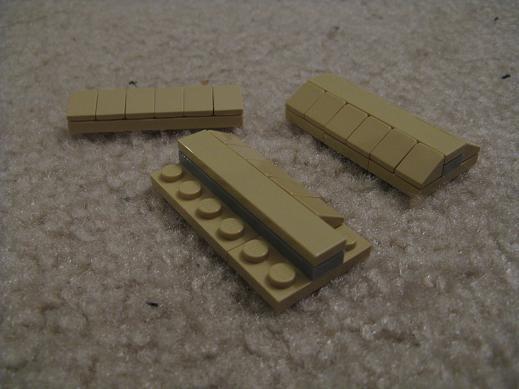
On the left you see one of the "skinny" examples, where it's just those bits on a stick. The middle shows a "wide" example under construction, with two rows of bits on either side of a central reinforcement. The right shows one of those, finished. Now look at the tower, with the second story done:
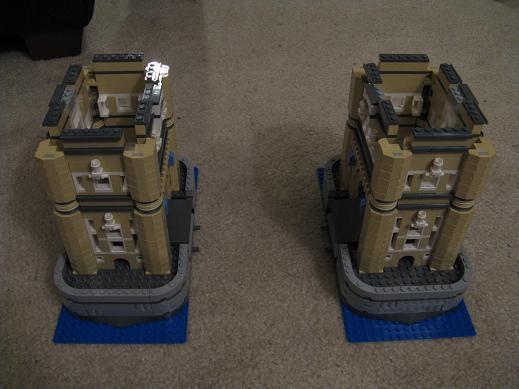
Those sort of octagonal corners? Are made up of the little bits. Wide pieces on the side facing you; the narrow ones go against the tower walls. Five hundred fifty-six of those bloody things, yo. And I'm not even done with them, at this stage.
Mind you, I think I prefer those to these:
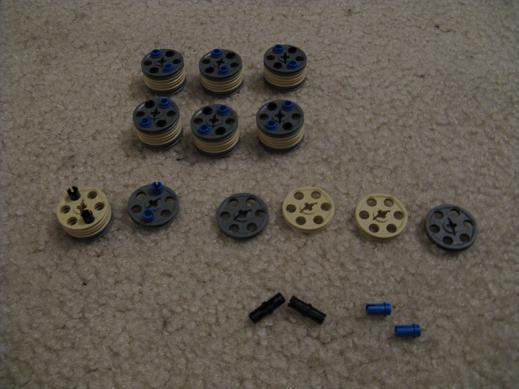
If you remember my other complaint, about my fingers hurting, that's because of these. Those four discs to the right, and the four pipes in front of them, combine into the stacks you see in back; left is one in progress. It's getting the long pipes from the one side and the short pipes from the other to fit into the opposing circles all at once that's a pain. (And no, it doesn't work to put all four pipes in one side.) Thank god I only had to do that for two stories.
Here's the third floor in progress:
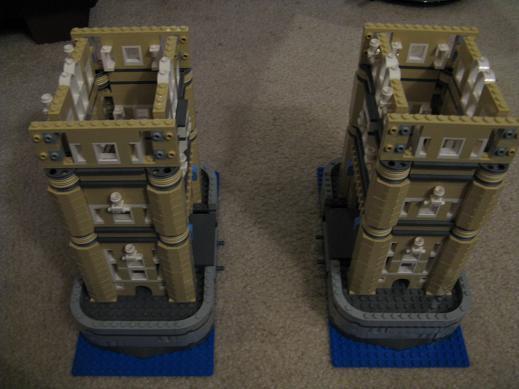
You can see the studs along the sides there; those are what the facing bits snap onto.
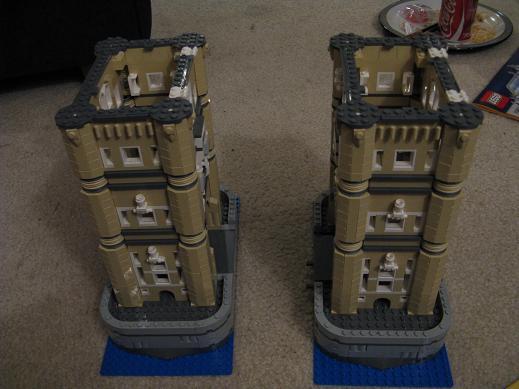
And there's the third floor completed, with the facings attached. No more little barrel bits, thank god; now we start setting things up for the walkway, which involves a great deal of very fiddly shifting of stud placement -- lots of those 2x1s that only have one stud on top, then things laid atop them to be slightly offset from the pieces below. (I have no idea if that description makes sense to anybody other than Lego enthusiasts. And maybe not even them. My vocabulary, it is made up on the spot.)
So that's Day Two. The next day, I only did a little work.
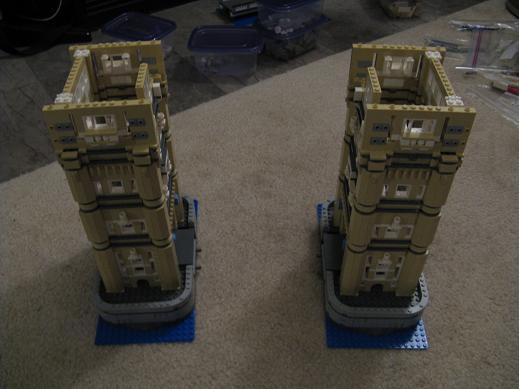
And here you can see the openings where the walkways will join in.
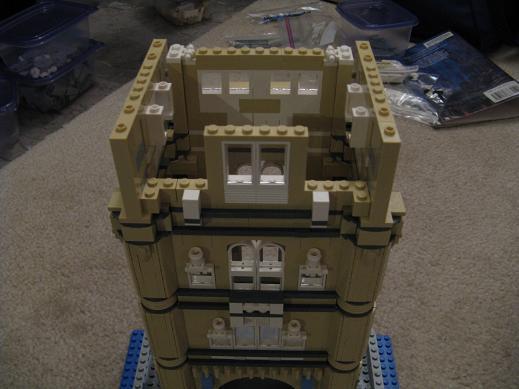
But at this point, you lot made trouble for me. See, some of you were very keen on seeing me stage that scene from Sherlock Holmes on the unfinished structure -- you know, the fight at the end. Well, I popped in the movie to take a look, and discovered that to make it look right, I would have to start doing things out of order, and pray that jumping around didn't make me miss a step.
The things I do for you people.
Accordingly, I went and built the roadways for either side of the towers:
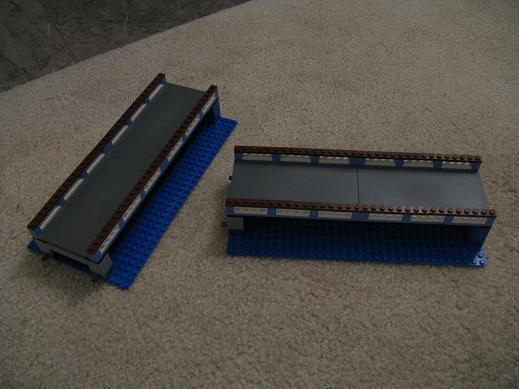
They look a lot like the one from the beginning of Day One, except these aren't hinged. After that, we build squid tentacles:
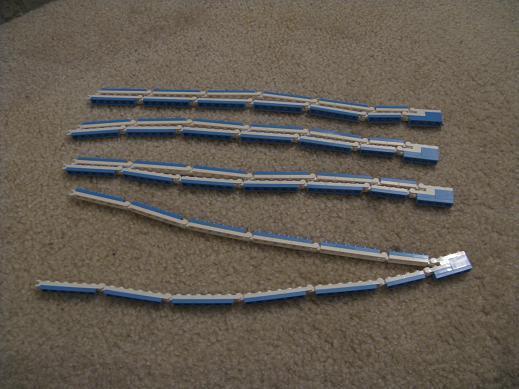
By which I mean suspension cables. About eight thousand white hinges and blue sticks got used up in very short order. Sadly, I don't have a specific shot of them being attached to the towers; you'll have to look for that in the later photos.
At this point, I diverged substantially from the instructions, deliberately half-building the walkways in the wrong order so as to get the right visual for the fight scene. But I think I'll leave those pictures until last, and give you Day Four first.
These are the walkways in question:
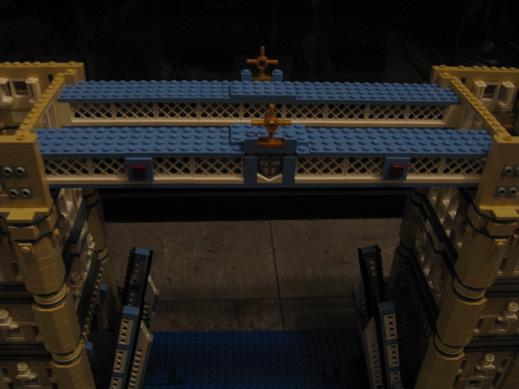
Forgot to turn on the extra light, so it's a bit dim. But thanks to there being two of them, you can see both the front and back sides. (And in the fight shots, you'll be able to see some of the interior structure.) The detail around the shields is particularly nice.
The tops of the towers look like bitty little houses:
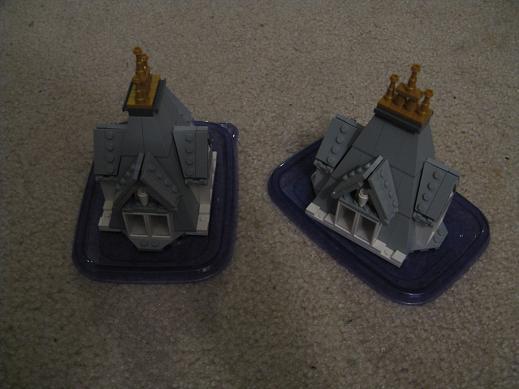
Little Norwegian houses, maybe, with the pitch of those roofs. With very elaborate gold chimneys. The corner sub-towers, on the other hand, look like space capsules from the Apollo era:
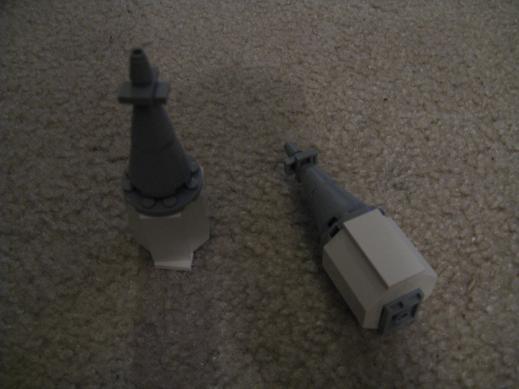
Stick the tops and sub-towers on, and . . . .
Voila!
Yes, it comes with adorable little vehicles. One cab, one personal car, one lorry (into which I put a couple of extra pipes), and one double-decker bus (of course). And now you can see the squid tentacles suspension cables in place.
From another angle, you get a better view of the tunnels through the towers:

Also of the knight who is our set of fireplace equipment. Yes, his halberd is a poker. It was a gift from my sister-in-law, who is fabulous.
And now, what at least some of you have been waiting for. I give you the Lego Re-Enactment of Sherlock Holmes' Climactic Scene:

The part of Sherlock Holmes is being played by Prince Philip. The part of Lord Blackwood is being played by Maleficent. The part of Irene Adler is being played by Merryweather. The ships below are being played by pieces from the Pirates of the Spanish Main game.
Look, they were the only figs I had that were even close to the right size.
And here's Blackwood/Maleficent coming to a sticky end:

I never thought I'd announce to the living room, "I just hanged Maleficent by the neck!"
Finally, just for![[info]](https://i.gr-assets.com/images/S/compressed.photo.goodreads.com/hostedimages/1380442897i/1319734.gif) gollumgollum
:
gollumgollum
:

Shinomori Aoshi and Lego Santa duking it out. They have to do so on the road, because no way in hell do they fit on the walkway. (And since leaving the walkway deliberately incomplete also left it structurally unsound; any more weight on it would have sent things tumbling downward.)
So there you have it. Five days' work, counting the "Day Zero" of sorting; I'd estimate it at maybe fifteen or twenty hours. Not that long, really. In fact, part of me is saying it wasn't nearly long enough, and clearly what I need is another giant Lego model to work on.
I don't. I really, really don't. But this one was very fun. Much love to![[info]](https://i.gr-assets.com/images/S/compressed.photo.goodreads.com/hostedimages/1380442897i/1319734.gif) kniedzw
, for knowing what kinds of presents his wife will love.
kniedzw
, for knowing what kinds of presents his wife will love.
So you get the rest of the photos all in a bunch, I'm afraid.
Remembering me complaining before about the little slope-y bitlets? Yeah, um, this is what I meant:

On the left you see one of the "skinny" examples, where it's just those bits on a stick. The middle shows a "wide" example under construction, with two rows of bits on either side of a central reinforcement. The right shows one of those, finished. Now look at the tower, with the second story done:

Those sort of octagonal corners? Are made up of the little bits. Wide pieces on the side facing you; the narrow ones go against the tower walls. Five hundred fifty-six of those bloody things, yo. And I'm not even done with them, at this stage.
Mind you, I think I prefer those to these:

If you remember my other complaint, about my fingers hurting, that's because of these. Those four discs to the right, and the four pipes in front of them, combine into the stacks you see in back; left is one in progress. It's getting the long pipes from the one side and the short pipes from the other to fit into the opposing circles all at once that's a pain. (And no, it doesn't work to put all four pipes in one side.) Thank god I only had to do that for two stories.
Here's the third floor in progress:

You can see the studs along the sides there; those are what the facing bits snap onto.

And there's the third floor completed, with the facings attached. No more little barrel bits, thank god; now we start setting things up for the walkway, which involves a great deal of very fiddly shifting of stud placement -- lots of those 2x1s that only have one stud on top, then things laid atop them to be slightly offset from the pieces below. (I have no idea if that description makes sense to anybody other than Lego enthusiasts. And maybe not even them. My vocabulary, it is made up on the spot.)
So that's Day Two. The next day, I only did a little work.

And here you can see the openings where the walkways will join in.

But at this point, you lot made trouble for me. See, some of you were very keen on seeing me stage that scene from Sherlock Holmes on the unfinished structure -- you know, the fight at the end. Well, I popped in the movie to take a look, and discovered that to make it look right, I would have to start doing things out of order, and pray that jumping around didn't make me miss a step.
The things I do for you people.
Accordingly, I went and built the roadways for either side of the towers:

They look a lot like the one from the beginning of Day One, except these aren't hinged. After that, we build squid tentacles:

By which I mean suspension cables. About eight thousand white hinges and blue sticks got used up in very short order. Sadly, I don't have a specific shot of them being attached to the towers; you'll have to look for that in the later photos.
At this point, I diverged substantially from the instructions, deliberately half-building the walkways in the wrong order so as to get the right visual for the fight scene. But I think I'll leave those pictures until last, and give you Day Four first.
These are the walkways in question:

Forgot to turn on the extra light, so it's a bit dim. But thanks to there being two of them, you can see both the front and back sides. (And in the fight shots, you'll be able to see some of the interior structure.) The detail around the shields is particularly nice.
The tops of the towers look like bitty little houses:

Little Norwegian houses, maybe, with the pitch of those roofs. With very elaborate gold chimneys. The corner sub-towers, on the other hand, look like space capsules from the Apollo era:

Stick the tops and sub-towers on, and . . . .
Voila!
Yes, it comes with adorable little vehicles. One cab, one personal car, one lorry (into which I put a couple of extra pipes), and one double-decker bus (of course). And now you can see the squid tentacles suspension cables in place.
From another angle, you get a better view of the tunnels through the towers:

Also of the knight who is our set of fireplace equipment. Yes, his halberd is a poker. It was a gift from my sister-in-law, who is fabulous.
And now, what at least some of you have been waiting for. I give you the Lego Re-Enactment of Sherlock Holmes' Climactic Scene:

The part of Sherlock Holmes is being played by Prince Philip. The part of Lord Blackwood is being played by Maleficent. The part of Irene Adler is being played by Merryweather. The ships below are being played by pieces from the Pirates of the Spanish Main game.
Look, they were the only figs I had that were even close to the right size.
And here's Blackwood/Maleficent coming to a sticky end:

I never thought I'd announce to the living room, "I just hanged Maleficent by the neck!"
Finally, just for
![[info]](https://i.gr-assets.com/images/S/compressed.photo.goodreads.com/hostedimages/1380442897i/1319734.gif) gollumgollum
:
gollumgollum
:
Shinomori Aoshi and Lego Santa duking it out. They have to do so on the road, because no way in hell do they fit on the walkway. (And since leaving the walkway deliberately incomplete also left it structurally unsound; any more weight on it would have sent things tumbling downward.)
So there you have it. Five days' work, counting the "Day Zero" of sorting; I'd estimate it at maybe fifteen or twenty hours. Not that long, really. In fact, part of me is saying it wasn't nearly long enough, and clearly what I need is another giant Lego model to work on.
I don't. I really, really don't. But this one was very fun. Much love to
![[info]](https://i.gr-assets.com/images/S/compressed.photo.goodreads.com/hostedimages/1380442897i/1319734.gif) kniedzw
, for knowing what kinds of presents his wife will love.
kniedzw
, for knowing what kinds of presents his wife will love.
Published on February 07, 2011 10:16
February 2, 2011
seeking a fanfic
I read part of a fic some time ago, and can't remember the title or the author's name or even where I read it (though I thought it was AO3) -- anyway, the story was a crossover that began with Anyanka (of Buffy) and Lois Lane (of Superman) in a bar, and then pulled in lots of other stuff as it went along. Anybody remember this one?
Published on February 02, 2011 04:50
February 1, 2011
Books read, January 2011
I've decided I want to experiment with the kind of book-log posts I see some of my friends making. No promises as to how long I'll keep this up, but since I'm looking forward to actually reading some fiction for the first time in forever, it's satisfying to track how much of it I've devoured in the last month.
The Game, Diana Wynne Jones. Short -- a novella rather than a novel -- and so I could say things here about how I wish the ideas had been developed out more or whatever. But the truth is I will read anything of hers you put in front of me and be pleased by it (and she may be the only author in the world about whom that is true for me), so whatever. I was pleased by it.
Enchanted Glass, Diana Wynne Jones. Longer, though not terribly long, and highly amusing in that distinctive DWJ way. She does quirky characterization so well; I very much enjoyed the interactions between Andrew and the Stocks, to the point of laughing out loud more than once. Quibbles here were that 1) I would have preferred it if Andrew and Aidan's names didn't begin with the same letter or else that the pov didn't slide so unobtrusively between them, 2) once the focus of the conflict became clear I really expected the ubiquity of the name "Stock" to become relevant, and 3) the final confrontation was not her most memorable. But it's Diana Wynne Jones, which means I read it and was pleased by it.
Act of Will, A.J. Hartley. Started off very well, with an engaging narrator, but it flagged as the story went on; I think it was trying to show something like a D&D adventuring-party story from a different angle, but when the momentum faltered it lost its feel of originality. Also, it never became clear (in this volume; it's the start of a series) why the author chose to put the invented setting in an academic frame from our own world. (Possibly it suffered by comparison to Mary Gentle's Book of Ash.)
The Immortals, Tamora Pierce.
Wolf-Speaker, Tamora Pierce.
Emperor Mage, Tamora Pierce.
The Realms of the Gods, Tamora Pierce. Re-reads, and probably for the last time. They are perfectly fine Tortall books, but not my favorites. I think I like the group dynamics that come packaged with the knight-oriented books (Alanna's and Keladry's), and I wanted more of the Daine/Numair romance. (Providing that latter, of course, would have required Daine to be older from the start, and I have a whole host of unformed thoughts about the technical and philosophical problems involved with a romance where the older, usually male, character has known the younger female character since she was a child. Daine isn't that young when Numair meets her, of course, but it's still a tricky path, and I find myself wondering how you would write its progression from his perspective.)
A friend's novel in manuscript. About which I will not say anything, except that I enjoyed it and hope she gets it into shape for submission soon.
Translations, Brian Friel. A short play rather than novel, which I read on a friend's recommendation (actually, the same friend as above) so as to better my command of Irish-English dialect before I did the copy-edits on With Fate Conspire. It takes place in Ireland during the 1830s, when the English government sent over surveyors to map and "standardize" (read: translate and/or Anglicize) all the place names. Deeply depressing in a lot of ways, especially with the way it keeps ostentatiously NOT looking straight at the violence and tragedy going on around its edges.
With Fate Conspire, Marie Brennan. Copy-edits don't count.
Shards of Honor, Lois McMaster Bujold. On advice, I began here. I agree with those who said it's weak; having read the afterword -- Baen's ebook dump of the series is all in omnibus form, though I'm counting the component novels individually -- I think I see why. Not only was it early work, she talks about how the plot kept growing and complexifying, until she lopped off what became Barrayar to be its own book, and this one feels a bit like I can see her trying to get that later narrative in gear. Writers talk sometimes about how basic craft includes learning to get the entire story out of your head and onto the page; certain bits of this one seem to have stayed behind in Bujold's head. I didn't mind the story, but it was as if I was reading A, B, C, E -- wait, what happened to D? oh well -- F, I, etc.
Barrayar, Lois McMaster Bujold. Noticeably stronger than its predecessor, thanks to several years and novels of practice in between. (I'm reading by internal chronological order, which means I'll be ricocheting around the compositional order.) The entire alphabet is here this time, and it welds the personal and political together quite well. I really enjoyed the byplay with Koudelka and Droushnakovi -- Cordelia's turns as the Baba are hilarious -- and am sad that they haven't appeared again in the later books I've read. Bothari . . . I'm not sure what I think about him. I don't have as much sympathy for him as the narrative seems to want me to, and I think it's because I don't believe in his insanity; IANA psychiatrist, but he feels fictionally insane to me, rather than realistically. I could be wrong about that. But his psychotic turns don't ring true to me, either in this book or the previous. (I did like his scene with Cordelia, though, about the bits he remembers. His comment about how her not being his victim doesn't make him any less of an offender was very much appreciated, given how many authors would have used that moment to try and absolve him of responsibility.)
The Warrior's Apprentice, Lois McMaster Bujold. Not as strong as Barrayar, but a lot better than Shards of Honor; I think it was written later, yes, though published in the same year? The chain of events by which Miles ends up ass-deep in alligators is decidedly silly, of course, but I'm okay with that. It isn't quite as much my cup of tea as the more dramatic Barrayar; that, however, is personal taste, because this is fine for what it is. I only wish it had spent more time on Barrayar before haring off into the wild blue plot-yonder, because I like to see characters in their home environments, and it makes the foreign adventures more interesting to me. (Lack of Barrayar might be one of my chiefer complaints so far, in all the Miles books. Barrayar, of course, has plenty.)
The Mountains of Mourning, Lois McMaster Bujold. Yay, more actual Barrayar! <g> This one's a novella, I think? The conflict is clearly meta-gamed by the author to be especially poignant to Miles, but I'll spot her that bit of narrative manipulation, because the story is good enough to support it. The judgment at the end was very well-chosen, I must say.
The Vor Game, Lois McMaster Bujold. I wasn't entirely a fan of how she arranged for the early, Kyril Island segment to be relevant to the space-based narrative that occupies the bulk of the book, and the process of prying Miles free of whats-his-face the ImpSec guy was more than a little on the contrived side; but once the Hegen Hub plot really got rolling, it was plenty of fun. (And seeing somebody refer to Gregor as "that skinny neurasthenic git" made me grin.)
Cetaganda, Lois McMaster Bujold. Yes, I've been mainlining these books. The omnibus format of the e-book dump encourages it, and they go quickly. Anyway, omg the worldbuilding in this one. My anthropological self loved watching Bujold cut loose on that front; Barrayar has interesting touches, but on the whole it feels moderately familiar -- medievalish society with tech grafted on top -- whereas Cetaganda is wildly speculative. The ghem vs. haut setup, the truly esoteric art, the etiquette and power games around the haut-women . . . I want more of this. And the plot was interestingly twisty, though ultimately its solution was less twisty than I'd been hoping for. I will admit, however, that reading in chronological order means I'm getting a whole lotta "Miles has no authority but he does something that get him into hot water so he contrives reasons for and methods of keeping things from his superiors until it all comes to a head and only he can solve it" -- a perfectly fine plot structure, but one that stales a bit after repeated doses. Fortunately, the next book up is Ethan of Athos, which provides a nice break-point at which to read other things.
(Here, have an unnecessary parenthetical aside to end this section, since half the reviews have one tacked on the end.)
Books started and abandoned this month: six. Something of a high number, owing to the ongoing bout of using the twenty-page test to thin out my shelves. I'll probably keep track of how many books I set aside, but I won't go into detail on them; in many cases it's just a matter of the book clearly being Not For Me, and in those cases where I put something down because of quality issues, I feel awkward about publicly critizing it based on such a small sample.
There may be spoilers for the Vorkosigan books in the comment, depending on how much people want to discuss my statements above.
The Game, Diana Wynne Jones. Short -- a novella rather than a novel -- and so I could say things here about how I wish the ideas had been developed out more or whatever. But the truth is I will read anything of hers you put in front of me and be pleased by it (and she may be the only author in the world about whom that is true for me), so whatever. I was pleased by it.
Enchanted Glass, Diana Wynne Jones. Longer, though not terribly long, and highly amusing in that distinctive DWJ way. She does quirky characterization so well; I very much enjoyed the interactions between Andrew and the Stocks, to the point of laughing out loud more than once. Quibbles here were that 1) I would have preferred it if Andrew and Aidan's names didn't begin with the same letter or else that the pov didn't slide so unobtrusively between them, 2) once the focus of the conflict became clear I really expected the ubiquity of the name "Stock" to become relevant, and 3) the final confrontation was not her most memorable. But it's Diana Wynne Jones, which means I read it and was pleased by it.
Act of Will, A.J. Hartley. Started off very well, with an engaging narrator, but it flagged as the story went on; I think it was trying to show something like a D&D adventuring-party story from a different angle, but when the momentum faltered it lost its feel of originality. Also, it never became clear (in this volume; it's the start of a series) why the author chose to put the invented setting in an academic frame from our own world. (Possibly it suffered by comparison to Mary Gentle's Book of Ash.)
The Immortals, Tamora Pierce.
Wolf-Speaker, Tamora Pierce.
Emperor Mage, Tamora Pierce.
The Realms of the Gods, Tamora Pierce. Re-reads, and probably for the last time. They are perfectly fine Tortall books, but not my favorites. I think I like the group dynamics that come packaged with the knight-oriented books (Alanna's and Keladry's), and I wanted more of the Daine/Numair romance. (Providing that latter, of course, would have required Daine to be older from the start, and I have a whole host of unformed thoughts about the technical and philosophical problems involved with a romance where the older, usually male, character has known the younger female character since she was a child. Daine isn't that young when Numair meets her, of course, but it's still a tricky path, and I find myself wondering how you would write its progression from his perspective.)
A friend's novel in manuscript. About which I will not say anything, except that I enjoyed it and hope she gets it into shape for submission soon.
Translations, Brian Friel. A short play rather than novel, which I read on a friend's recommendation (actually, the same friend as above) so as to better my command of Irish-English dialect before I did the copy-edits on With Fate Conspire. It takes place in Ireland during the 1830s, when the English government sent over surveyors to map and "standardize" (read: translate and/or Anglicize) all the place names. Deeply depressing in a lot of ways, especially with the way it keeps ostentatiously NOT looking straight at the violence and tragedy going on around its edges.
With Fate Conspire, Marie Brennan. Copy-edits don't count.
Shards of Honor, Lois McMaster Bujold. On advice, I began here. I agree with those who said it's weak; having read the afterword -- Baen's ebook dump of the series is all in omnibus form, though I'm counting the component novels individually -- I think I see why. Not only was it early work, she talks about how the plot kept growing and complexifying, until she lopped off what became Barrayar to be its own book, and this one feels a bit like I can see her trying to get that later narrative in gear. Writers talk sometimes about how basic craft includes learning to get the entire story out of your head and onto the page; certain bits of this one seem to have stayed behind in Bujold's head. I didn't mind the story, but it was as if I was reading A, B, C, E -- wait, what happened to D? oh well -- F, I, etc.
Barrayar, Lois McMaster Bujold. Noticeably stronger than its predecessor, thanks to several years and novels of practice in between. (I'm reading by internal chronological order, which means I'll be ricocheting around the compositional order.) The entire alphabet is here this time, and it welds the personal and political together quite well. I really enjoyed the byplay with Koudelka and Droushnakovi -- Cordelia's turns as the Baba are hilarious -- and am sad that they haven't appeared again in the later books I've read. Bothari . . . I'm not sure what I think about him. I don't have as much sympathy for him as the narrative seems to want me to, and I think it's because I don't believe in his insanity; IANA psychiatrist, but he feels fictionally insane to me, rather than realistically. I could be wrong about that. But his psychotic turns don't ring true to me, either in this book or the previous. (I did like his scene with Cordelia, though, about the bits he remembers. His comment about how her not being his victim doesn't make him any less of an offender was very much appreciated, given how many authors would have used that moment to try and absolve him of responsibility.)
The Warrior's Apprentice, Lois McMaster Bujold. Not as strong as Barrayar, but a lot better than Shards of Honor; I think it was written later, yes, though published in the same year? The chain of events by which Miles ends up ass-deep in alligators is decidedly silly, of course, but I'm okay with that. It isn't quite as much my cup of tea as the more dramatic Barrayar; that, however, is personal taste, because this is fine for what it is. I only wish it had spent more time on Barrayar before haring off into the wild blue plot-yonder, because I like to see characters in their home environments, and it makes the foreign adventures more interesting to me. (Lack of Barrayar might be one of my chiefer complaints so far, in all the Miles books. Barrayar, of course, has plenty.)
The Mountains of Mourning, Lois McMaster Bujold. Yay, more actual Barrayar! <g> This one's a novella, I think? The conflict is clearly meta-gamed by the author to be especially poignant to Miles, but I'll spot her that bit of narrative manipulation, because the story is good enough to support it. The judgment at the end was very well-chosen, I must say.
The Vor Game, Lois McMaster Bujold. I wasn't entirely a fan of how she arranged for the early, Kyril Island segment to be relevant to the space-based narrative that occupies the bulk of the book, and the process of prying Miles free of whats-his-face the ImpSec guy was more than a little on the contrived side; but once the Hegen Hub plot really got rolling, it was plenty of fun. (And seeing somebody refer to Gregor as "that skinny neurasthenic git" made me grin.)
Cetaganda, Lois McMaster Bujold. Yes, I've been mainlining these books. The omnibus format of the e-book dump encourages it, and they go quickly. Anyway, omg the worldbuilding in this one. My anthropological self loved watching Bujold cut loose on that front; Barrayar has interesting touches, but on the whole it feels moderately familiar -- medievalish society with tech grafted on top -- whereas Cetaganda is wildly speculative. The ghem vs. haut setup, the truly esoteric art, the etiquette and power games around the haut-women . . . I want more of this. And the plot was interestingly twisty, though ultimately its solution was less twisty than I'd been hoping for. I will admit, however, that reading in chronological order means I'm getting a whole lotta "Miles has no authority but he does something that get him into hot water so he contrives reasons for and methods of keeping things from his superiors until it all comes to a head and only he can solve it" -- a perfectly fine plot structure, but one that stales a bit after repeated doses. Fortunately, the next book up is Ethan of Athos, which provides a nice break-point at which to read other things.
(Here, have an unnecessary parenthetical aside to end this section, since half the reviews have one tacked on the end.)
Books started and abandoned this month: six. Something of a high number, owing to the ongoing bout of using the twenty-page test to thin out my shelves. I'll probably keep track of how many books I set aside, but I won't go into detail on them; in many cases it's just a matter of the book clearly being Not For Me, and in those cases where I put something down because of quality issues, I feel awkward about publicly critizing it based on such a small sample.
There may be spoilers for the Vorkosigan books in the comment, depending on how much people want to discuss my statements above.
Published on February 01, 2011 10:13
writers are messed-up people, yo
Within fifteen seconds of being kicked in the head during karate tonight, a part of me was thinking, "I should pay attention to what this feels like, in case I need it for a story."
For the curious: very brief disorientation; swift (and only partially voluntary) decision that it would be better if I put my center of gravity lower for a few seconds, i.e. knelt on the floor; massive radiating heat from my ear lasting for a good half hour or more afterward. (It's still red now, an hour later, though not swollen.) Oddly, the most painful spot is actually the skin in the crease behind my ear; presumably that has something to do with the cartilege being mashed by the impact.
(I was not kicked with any great force. Though admittedly, when one's kumite partner is six foot three, "not with any great force" is still enough to be troublesome. And more than enough to guilt one's kumite partner with -- especially when he is also one's husband. ^_^)
For the curious: very brief disorientation; swift (and only partially voluntary) decision that it would be better if I put my center of gravity lower for a few seconds, i.e. knelt on the floor; massive radiating heat from my ear lasting for a good half hour or more afterward. (It's still red now, an hour later, though not swollen.) Oddly, the most painful spot is actually the skin in the crease behind my ear; presumably that has something to do with the cartilege being mashed by the impact.
(I was not kicked with any great force. Though admittedly, when one's kumite partner is six foot three, "not with any great force" is still enough to be troublesome. And more than enough to guilt one's kumite partner with -- especially when he is also one's husband. ^_^)
Published on February 01, 2011 05:48
January 28, 2011
first lines meme, novels edition
You know how I recently mentioned that my mental queue of Books I Could Write includes twenty-two entries in six series? It's more than that, really, when you count the standalones and the things I've already written but haven't sold and son on. Rather than do a first lines meme for short stories (which are kind of guilting me right now), I thought it might be fun to tally up all the openings for the novels. Note that most of these are currently laboring under working titles, and for shits and giggles I'll include some I think are dead in the water.
Lies and Prophecy
Manifestation
The Sorcerers of Kyoto
Behind the Shadows
[No opening line, but I can quote you the line that sent the idea springing full-figure into my head:]
Holy Vows
The Changing Sea
A Natural History of Dragons
The Lieutenant's Tale
Either
or
The Mother of the End
Not So Perfect
The Waking of Angantyr
Sunlight and Storm
The Vengeance of Trees
the book that is not allowed to be called The Book of Kells
untitled book based on a horrible dream I once had
dragons book I probably won't ever write
The Kestori Hawks (trunked)
Plus The Iron Rose, which doesn't have an opening line, because I've never gotten around to writing any of it.
And, just to tease you all, the opening paragraph of With Fate Conspire:
Lies and Prophecy
Linwood Hall was a lovely building -- one of the nicest on Welton's campus -- but I had no chance to appreciate it as I flung the double doors open and ran up the central staircase.
Manifestation
On Tuesday morning Henry Welton woke up insane.[Yes, this is connected to the above. But separated by several generations.]
The Sorcerers of Kyoto
Mara leaned forward to gape through the front window of the rental car. "I thought you said this was a house."
Behind the Shadows
[No opening line, but I can quote you the line that sent the idea springing full-figure into my head:]
Centuries ago, a prophecy was spoken, that one day a hero would be born, the last descendent of a forgotten royal line, to overthrow the forces of the Midnight Queen and thereafter reign as king.
Some people weren't inclined to wait.
Holy Vows
Sweat coated Sola's face, soaked all through her hair, threatened to overrun the protecting line of her brows and sting her eyes.
The Changing Sea
The ship's serrated prow cut a clean line through the shifting, hypnotic waters of the Changing Sea.
A Natural History of Dragons
Not a day goes by that the post does not bring me at least one letter from a young person (or sometimes one not so young) who wishes to follow in my footsteps and become a dragon naturalist.
The Lieutenant's Tale
Either
Salt spray peppered my face as I paced back and forth along the flat granite slab the locals called the Widow's Walk.
or
The skies were clear and the winds fair for Plymouth, the Hesperides flying before them like a swan, her wings unfurled from the yardarms and belling out full.depending on where the story starts. (The latter is more likely.)
The Mother of the End
Word came to the temple of Harina-Madhul-Sri on the first truly warm day that spring.
Not So Perfect
I am not the Bitch Queen of Candleton High.
The Waking of Angantyr
Dead men had whispered to her in her sleep for so long that she had almost gotten used to it.
Sunlight and Storm
Had Sarah Whitby merely died, it would not have caused such a fuss.
The Vengeance of Trees
"You ran from me once. That summer day, at your uncle's manor, we each took steps that led us away from here, did things which should have made today impossible. But you were a mere girl then, and I a stripling boy, and a fool at that. I ask you now to put that memory behind you, to -- line!"
"To stay the feet that --"
"To stay the feet that would flee again!"
the book that is not allowed to be called The Book of Kells
I don't even know why it's so important.
untitled book based on a horrible dream I once had
The dark car cruises along the deserted streets, and there is darkness both inside and outside.
dragons book I probably won't ever write
The grey clouds were lowering threateningly over the walls of the keep as the dragon backwinged to land in the broad courtyard.
The Kestori Hawks (trunked)
In his world, pain was routine.
Plus The Iron Rose, which doesn't have an opening line, because I've never gotten around to writing any of it.
And, just to tease you all, the opening paragraph of With Fate Conspire:
The lights hovered in mid-air, like a cloud of unearthly fireflies. The corners of the room lay in shadow; all illumination had drawn inward, to this spot before the empty hearth, and the woman who stood there in silence.
Published on January 28, 2011 09:53
January 27, 2011
newsletters make it official
If you are San Francisco Bay Area-local, or capable of traveling here in March, you might want to check out FOGcon. It's a new con starting up March 11-13, with a theme this year of "The City in SF/F;" having looked at their programming possibilities, they definitely have some interesting and varied ideas for how to approach that topic.
I'll be there, and will presumably be on at least one panel. Furthermore -- I guess it's official, since it got mentioned in the recent newsletter -- I'll be running one of their writing workshops. Looks like the setup will be stories under 10K, submitted with cover letter by February 15th; default arrangement is for a Clarion-style workshop, with each student reading and critting the other pieces in addition to the instructor's feedback. Erin Cashier, Jed Hartman, and David Levine are the other instructors, and we're each getting our own section, so if you have a preference for one or another of us (or want to specifically run away from me), mention that in your cover letter.
(This will actually be the first time I've run a workshop like this at a con. But I have taught writing before, for one semester.)
Anyway, if you're interested, register soon! I hope to see some of you there.
I'll be there, and will presumably be on at least one panel. Furthermore -- I guess it's official, since it got mentioned in the recent newsletter -- I'll be running one of their writing workshops. Looks like the setup will be stories under 10K, submitted with cover letter by February 15th; default arrangement is for a Clarion-style workshop, with each student reading and critting the other pieces in addition to the instructor's feedback. Erin Cashier, Jed Hartman, and David Levine are the other instructors, and we're each getting our own section, so if you have a preference for one or another of us (or want to specifically run away from me), mention that in your cover letter.
(This will actually be the first time I've run a workshop like this at a con. But I have taught writing before, for one semester.)
Anyway, if you're interested, register soon! I hope to see some of you there.
Published on January 27, 2011 20:40
January 26, 2011
as the industry moves online
An Archive of Our Own, one of the big fanfic sites, is working on implementing "subscriptions," where you can designate particular authors (or fandoms or tags or what-have-you) and be informed when new stories get posted.
It occurs to me that, as more and more short fiction publishing moves online, how useful this could be. I mean, I post links when stories of mine go up, so if you read my LJ you hear about those things. But that requires you to follow a bunch of different separate feeds, and it buries the story links in the noise of everything else you read. Maybe some online 'zines tag their stories in a way that allows you to tell Google Reader or whatever, tell me whenever Clarkesworld publishes a Cat Valente story -- I don't know; I haven't tried -- but if she then publishes a story in Lightspeed instead, you won't know about it. How technically difficult would it be to create an aggregator site that covers all the online 'zines (ending at whatever bar the site's operator chooses), and then once you pick an author from their database, notifies you whenever that author publishes something, wherever it might be? I have no idea; IANenough of a webgeek to do that kind of thing myself. I imagine it would require some amount of cooperation from the publisher's side, tagging the pages according to the aggregator's requirements, etc. The benefit, however, is that it drives traffic to your site; and if I discover a lot of the writers I've subscribed to are being published in Beneath Ceaseless Skies, I might start checking out who else they print, because clearly that place fits my taste. (Heck, print magazines could even benefit, with a blog that advertises the latest ToC.)
I dunno -- maybe it would weaken the sense of loyalty to particular publications in favor of the writers. We still haven't solved the problem of funding online magazines, and if something like this makes it harder for Strange Horizons to raise money, etc, because people are no longer self-identifying as "SH readers" but readers of one author or another, then that would be a problem. But if you really like Aliette de Bodard's Xuya stories, it would be neat to have something automatically alert you when one of them pops up, even if it's in a place you don't normally look. It seems to me this fits with the a la carte trend I'm seeing in how we consume media: Tivo to pull down the programs we want to watch, iTunes selling us individual tracks instead of whole albums, etc. I'm reading some serialized stories online, and I know having new chapters pop up in my reader, without me having to go check for updates, is damned convenient. If short story publishing in general had something like this, I'd use it in a heartbeat.
It occurs to me that, as more and more short fiction publishing moves online, how useful this could be. I mean, I post links when stories of mine go up, so if you read my LJ you hear about those things. But that requires you to follow a bunch of different separate feeds, and it buries the story links in the noise of everything else you read. Maybe some online 'zines tag their stories in a way that allows you to tell Google Reader or whatever, tell me whenever Clarkesworld publishes a Cat Valente story -- I don't know; I haven't tried -- but if she then publishes a story in Lightspeed instead, you won't know about it. How technically difficult would it be to create an aggregator site that covers all the online 'zines (ending at whatever bar the site's operator chooses), and then once you pick an author from their database, notifies you whenever that author publishes something, wherever it might be? I have no idea; IANenough of a webgeek to do that kind of thing myself. I imagine it would require some amount of cooperation from the publisher's side, tagging the pages according to the aggregator's requirements, etc. The benefit, however, is that it drives traffic to your site; and if I discover a lot of the writers I've subscribed to are being published in Beneath Ceaseless Skies, I might start checking out who else they print, because clearly that place fits my taste. (Heck, print magazines could even benefit, with a blog that advertises the latest ToC.)
I dunno -- maybe it would weaken the sense of loyalty to particular publications in favor of the writers. We still haven't solved the problem of funding online magazines, and if something like this makes it harder for Strange Horizons to raise money, etc, because people are no longer self-identifying as "SH readers" but readers of one author or another, then that would be a problem. But if you really like Aliette de Bodard's Xuya stories, it would be neat to have something automatically alert you when one of them pops up, even if it's in a place you don't normally look. It seems to me this fits with the a la carte trend I'm seeing in how we consume media: Tivo to pull down the programs we want to watch, iTunes selling us individual tracks instead of whole albums, etc. I'm reading some serialized stories online, and I know having new chapters pop up in my reader, without me having to go check for updates, is damned convenient. If short story publishing in general had something like this, I'd use it in a heartbeat.
Published on January 26, 2011 20:02
January 24, 2011
Lego Tower Bridge Photoblog: Days Zero and One
There was enough interest in a photoblog of my progress on the Lego Tower Bridge that I decided to go ahead with it.
Here's something you have to understand: I love spatial stuff. Every Christmas, my mother, my brother, and I do a holiday jigsaw puzzle. I think they're generally a thousand pieces -- whatever fits on the kitchen counter, anyway -- and we polish them off in a few days flat, in part because I will kind of just sit there and put pieces in until somebody makes me stop. A few years ago I suggested we try one of those 3D jigsaw puzzles, and ended up doing ninety percent of it myself, because I was the one who really wanted it; the puzzle was Neuschwanstein, and it still sits atop my desk at home. Last month my mother said I could have gone to work for Lego as one of their designers, and it's probably true; spatial reasoning has always been one of my strong suits.
So this is a most excellent present for my husband to have gotten for me. And, like the Christmas jigsaw puzzles, I'm inclined to marathon on it unless somebody makes me stop. Since I have work to do, I've imposed a self-restriction, which is that I'm only allowed to play with the Legos while watching movies with friends. At the moment, we have plans to do movie double-headers every Sunday night for a while, so you'll likely get Monday updates to the photoblog.
Behind the cut, for the sake of people's flists, you'll find the progress from Day Zero and Day One.
Four thousand two hundred eighty-seven pieces in twenty-eight sacks. Piled up, it looks like this:
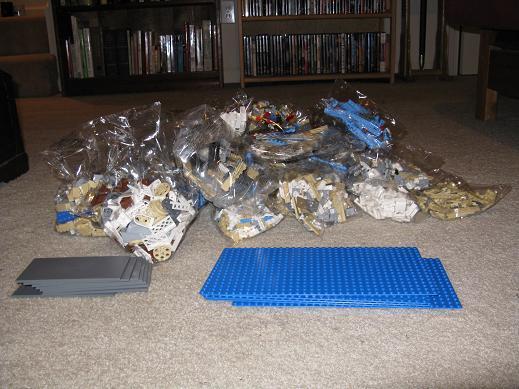
Kind of unmanageable, ne? Fortunately,![[info]](https://i.gr-assets.com/images/S/compressed.photo.goodreads.com/hostedimages/1380442897i/1319734.gif) kniedzw
still had the bins and ziploc bags from when he built the Lego Taj Mahal at work, so the Day Zero step was to open all those sacks and sort the pieces into something resembling order:
kniedzw
still had the bins and ziploc bags from when he built the Lego Taj Mahal at work, so the Day Zero step was to open all those sacks and sort the pieces into something resembling order:

There, that's better. (I did not, however, count all the damn pieces, unlike my deranged husband and his project. One of the few instances in which I am less obsessive-compulsive than him.) Part of the reason I refused to count is right here:

Five hundred fifty-six pieces -- more than ten percent of the total -- are these little 1x1 tan slope-y bits. (You'll see why later on.) I was damned if I was going to count them all.
Oh, and these are the instruction books:
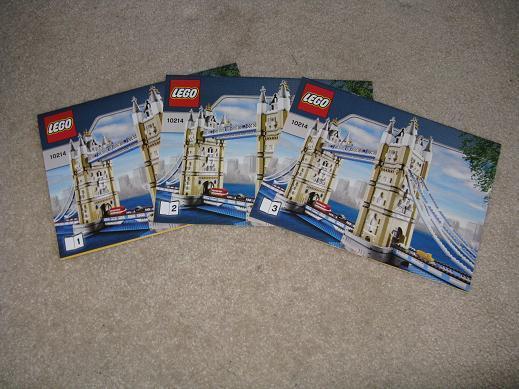
That doesn't give you any sense of how many pages there are, but whatever. Like I said, they're magazine-sized.
On to the actual building. The first thing you construct, going by the directions, is the central span of bridge, the moveable part:
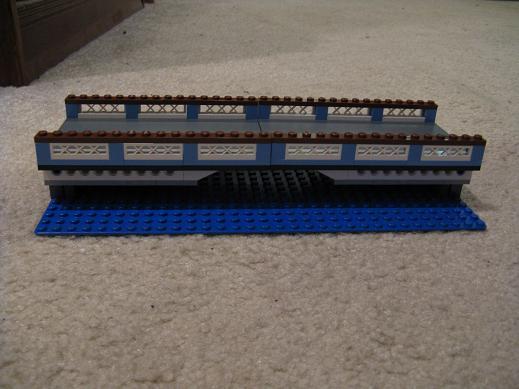
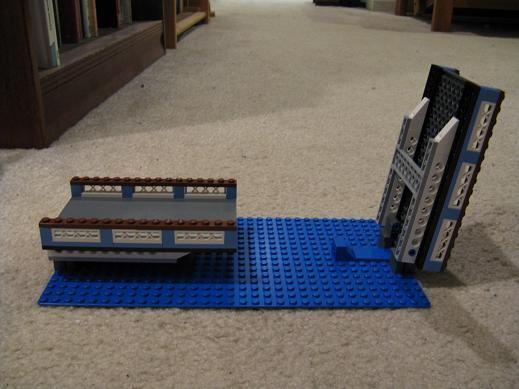
I'm convinced they have you build that first so you can experience the satisfaction of completing a sizeable-looking chunk of the whole. Enjoy that satisfaction, because it's going to be a while before you experience it again; next up are the towers.
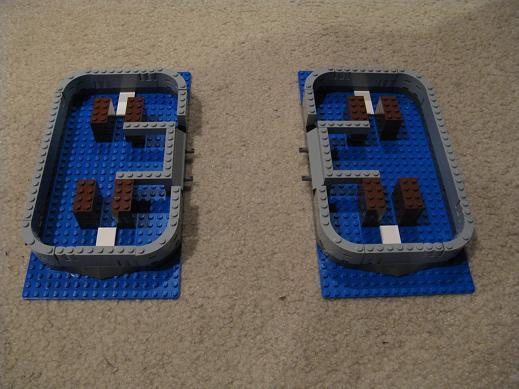
As you can see, I chose to build them in parallel, rather than doing first one and then the other. This has nothing to do with plans to stage scenes from Sherlock Holmes atop the unfinished structure, no sirree.
I've never done one of these Lego projects before, the big ones that replicate a real-world structure, and I'm fascinated by the attention to detail. Because my lighting is crappy (I'll try to do better in the future), you can't see this, but there's stuff in the foundation that is, when you get down to it, unnecessary. Those piles in the middle are three brown standard bricks each, the middle one offset by one space, to provide an attachment point for the grey bars. The offset space is filled by a semi-specialized dark grey piece, 1x2 but rounded into two semi-cylinders. Once the foundation is finished, those pieces are invisible. You cannot possibly see them. They could have been hot pink and spiky, for all anybody but the builder would know. But somebody went to the effort of choosing something appropriate; I can only presume it's based on the actual structure. This happens again and again as I go along, and every time it does, I grin a little in pleasure.
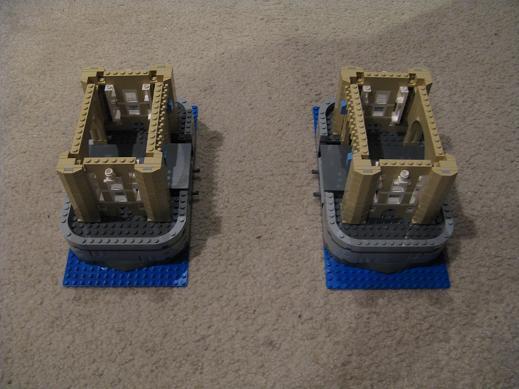
Here's the first story of the towers completed. (Dim lighting, I know; I'll fix that for later shots.) Those rounded corners are where all those fiddly little tan bits are going: you stick them onto underlying pieces in long lines, then stick those pieces onto side-projecting bits. Very tedious work, but good for watching movies, as it doesn't require a lot of attention.
I didn't work constantly through both movies, but I spent a goodly portion of that time on Lego-building, and here's where I got to in the end:
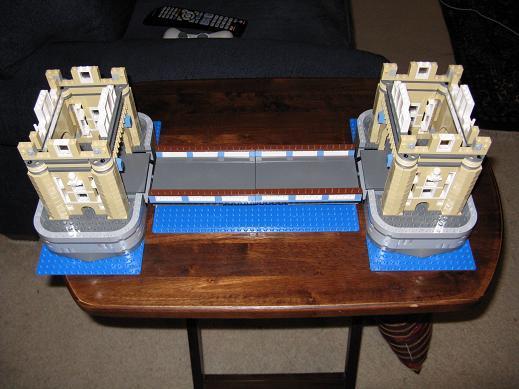
Not a bad start, I think. And here, since I used flash, you can see detail much better: the corners of the towers, and down in the light grey foundation some of the semi-rounded bits I mentioned before. The barrel-like bits marking the top of the first story and base of the second are a pain, quite physically; you have to stick four roundels onto pipe pieces, then force additional pipes into the stack so the horizontal pieces that attach the stacks to the rest of the structure have something to latch onto. My fingers hurt by the time I was done.
I haven't yet attached the central bridge to the towers. You're supposed to do that after the towers are done, but I think I'll delay; the only thing connecting those bases are two little pipes on each side, and since I have to lift the entire mess up onto my office bookcases when I'm done, I'll probably do the last stages of assembly up there. (This thing is going to be heavy, y'all. Not so much in the grand scheme of things, but more than I want to trust to a pair of little pipes.)
Anyway, it's good progress. I'm maybe twenty percent of the way done, though it's hard to judge for sure, since some pages are a lot more complicated than others. I haven't yet finished the first booklet, though. That will have to wait for next Sunday, when I get to work on this again.
Here's something you have to understand: I love spatial stuff. Every Christmas, my mother, my brother, and I do a holiday jigsaw puzzle. I think they're generally a thousand pieces -- whatever fits on the kitchen counter, anyway -- and we polish them off in a few days flat, in part because I will kind of just sit there and put pieces in until somebody makes me stop. A few years ago I suggested we try one of those 3D jigsaw puzzles, and ended up doing ninety percent of it myself, because I was the one who really wanted it; the puzzle was Neuschwanstein, and it still sits atop my desk at home. Last month my mother said I could have gone to work for Lego as one of their designers, and it's probably true; spatial reasoning has always been one of my strong suits.
So this is a most excellent present for my husband to have gotten for me. And, like the Christmas jigsaw puzzles, I'm inclined to marathon on it unless somebody makes me stop. Since I have work to do, I've imposed a self-restriction, which is that I'm only allowed to play with the Legos while watching movies with friends. At the moment, we have plans to do movie double-headers every Sunday night for a while, so you'll likely get Monday updates to the photoblog.
Behind the cut, for the sake of people's flists, you'll find the progress from Day Zero and Day One.
Four thousand two hundred eighty-seven pieces in twenty-eight sacks. Piled up, it looks like this:

Kind of unmanageable, ne? Fortunately,
![[info]](https://i.gr-assets.com/images/S/compressed.photo.goodreads.com/hostedimages/1380442897i/1319734.gif) kniedzw
still had the bins and ziploc bags from when he built the Lego Taj Mahal at work, so the Day Zero step was to open all those sacks and sort the pieces into something resembling order:
kniedzw
still had the bins and ziploc bags from when he built the Lego Taj Mahal at work, so the Day Zero step was to open all those sacks and sort the pieces into something resembling order:
There, that's better. (I did not, however, count all the damn pieces, unlike my deranged husband and his project. One of the few instances in which I am less obsessive-compulsive than him.) Part of the reason I refused to count is right here:

Five hundred fifty-six pieces -- more than ten percent of the total -- are these little 1x1 tan slope-y bits. (You'll see why later on.) I was damned if I was going to count them all.
Oh, and these are the instruction books:

That doesn't give you any sense of how many pages there are, but whatever. Like I said, they're magazine-sized.
On to the actual building. The first thing you construct, going by the directions, is the central span of bridge, the moveable part:


I'm convinced they have you build that first so you can experience the satisfaction of completing a sizeable-looking chunk of the whole. Enjoy that satisfaction, because it's going to be a while before you experience it again; next up are the towers.

As you can see, I chose to build them in parallel, rather than doing first one and then the other. This has nothing to do with plans to stage scenes from Sherlock Holmes atop the unfinished structure, no sirree.
I've never done one of these Lego projects before, the big ones that replicate a real-world structure, and I'm fascinated by the attention to detail. Because my lighting is crappy (I'll try to do better in the future), you can't see this, but there's stuff in the foundation that is, when you get down to it, unnecessary. Those piles in the middle are three brown standard bricks each, the middle one offset by one space, to provide an attachment point for the grey bars. The offset space is filled by a semi-specialized dark grey piece, 1x2 but rounded into two semi-cylinders. Once the foundation is finished, those pieces are invisible. You cannot possibly see them. They could have been hot pink and spiky, for all anybody but the builder would know. But somebody went to the effort of choosing something appropriate; I can only presume it's based on the actual structure. This happens again and again as I go along, and every time it does, I grin a little in pleasure.

Here's the first story of the towers completed. (Dim lighting, I know; I'll fix that for later shots.) Those rounded corners are where all those fiddly little tan bits are going: you stick them onto underlying pieces in long lines, then stick those pieces onto side-projecting bits. Very tedious work, but good for watching movies, as it doesn't require a lot of attention.
I didn't work constantly through both movies, but I spent a goodly portion of that time on Lego-building, and here's where I got to in the end:

Not a bad start, I think. And here, since I used flash, you can see detail much better: the corners of the towers, and down in the light grey foundation some of the semi-rounded bits I mentioned before. The barrel-like bits marking the top of the first story and base of the second are a pain, quite physically; you have to stick four roundels onto pipe pieces, then force additional pipes into the stack so the horizontal pieces that attach the stacks to the rest of the structure have something to latch onto. My fingers hurt by the time I was done.
I haven't yet attached the central bridge to the towers. You're supposed to do that after the towers are done, but I think I'll delay; the only thing connecting those bases are two little pipes on each side, and since I have to lift the entire mess up onto my office bookcases when I'm done, I'll probably do the last stages of assembly up there. (This thing is going to be heavy, y'all. Not so much in the grand scheme of things, but more than I want to trust to a pair of little pipes.)
Anyway, it's good progress. I'm maybe twenty percent of the way done, though it's hard to judge for sure, since some pages are a lot more complicated than others. I haven't yet finished the first booklet, though. That will have to wait for next Sunday, when I get to work on this again.
Published on January 24, 2011 22:11
January 22, 2011
my break from the copy-edits
![[info]](https://i.gr-assets.com/images/S/compressed.photo.goodreads.com/hostedimages/1380442897i/1319734.gif) kniedzw
gave me my Valentine's Day present early, on the grounds that it would be better for me to have it before I finish the last major work on With Fate Conspire:
kniedzw
gave me my Valentine's Day present early, on the grounds that it would be better for me to have it before I finish the last major work on With Fate Conspire: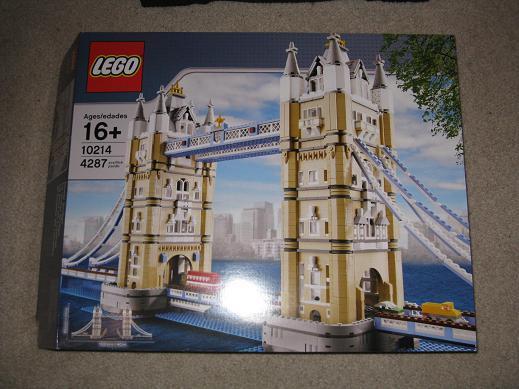
Four thousand two hundred eighty-seven pieces in twenty-eight sacks. Three magazine-sized instruction booklets; god knows how many steps in total, especially since after you go through all eighty-one stages (not counting sub-stages) to build one tower, you do it all over again for the second one.
This is gonna take a while.
I may photoblog the process. (And, as
![[info]](https://i.gr-assets.com/images/S/compressed.photo.goodreads.com/hostedimages/1380442897i/1319734.gif) kniedzw
suggested, try to stage that ending scene from Sherlock Holmes on the unfinished structure.)
kniedzw
suggested, try to stage that ending scene from Sherlock Holmes on the unfinished structure.)
Published on January 22, 2011 20:21



